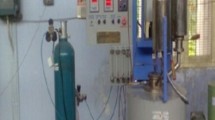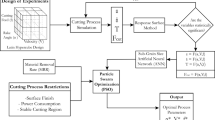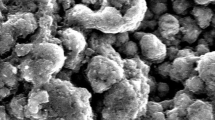Abstract
Machinability contribution to manufacturing is significant and its role for optimum has to be determined. Aluminum particulate reinforced compound has demand in some growing fields such as automotive, aircraft and locomotive industries. The research work focuses on machinability and optimization of machining parameters on Aluminum 6063 alloy reinforced with silicon carbide known as aluminum compound. Three specimens A, B, C reinforced with silicon carbide 3%, 6%, and 9%, respectively, were fabricated using stir cast. For each specimen, 13 experiments were conducted with varying input parameters such as speed, feed, and cutting depth in CNC vertical machining center using 10 mm end mill cutter. The recorded output responses are surface roughness and material removal rate. Using Design-Expert software’s RSM method, number of runs and regression equations were decided. The Turbo C program utilized and carried out the sorting of output measurement. The more focus is laid on the significance of machinability. The objective is to enhance parametric optimization using particle swarm optimization (PSO) method to calculate the fitness value corresponding to speed, feed, and cutting depth. The Multiobjective optimization of the input parameters obtained from particle swarm optimization found to have optimum to measure the output responses of surface finish process and output responses of material removal rate of the both are compared.
Access provided by Autonomous University of Puebla. Download conference paper PDF
Similar content being viewed by others
Keywords
- Particulate reinforced composite milling forces
- Surface roughness
- Machinability
- Particle swarm optimization
1 Introduction
Israelites using clay bricks and lined with straw are an early example of composites technology [1]. A composite generally defined as the combination of two or more macro-scale components with two or more distinct phases with recognizable interfaces between them. Composites are commonly used for their structural properties where the most commonly used reinforcing component is in particulate or fibrous form, and therefore the above definition can be limited to such systems containing a continuous/discontinuous fiber or particle reinforcement, all in a continuous supporting core phase, the matrix [1]. There are two phases that have continuous character namely matrix phase and primary phase. The second phases are reinforcement phase that is imbedded in the matrix in a discontinuous form. Composite efficiency depends on matrix and strengthening properties, size and distribution of constituents [2].
An evolutionary optimization technique includes single-pass SA, GA, and PSO, multi-pass turning and surface grinding. Input parameters are number of passes, cutting speed, feed and depth of cut, whereas output parameters are production cost and removal rate. Concluded that PSO meets this condition problem than GA and SA, since there is low number of iterations [3]. Alumina reinforced aluminum corrosion actions 6063 metal matrix composites. The influence of alumina volume percent and solution heat-treatment in salt water, basic, and acidic environments on the corrosion behavior of Al (6063) composites and their monolithic alloy. Al (6063) composites containing 6, 9, 15, and 18% of volume, and alumina were developed by using two-step stir casting [4]. Optimization of the end milling parameters and SiCp spindle speed and content was found to have greater influence on tool flank wear in end milling of LM25 Al/SiCp MMC, followed by feed rate. Tool flank wear is less influenced for depth of cut [5]. Estimation of optimum values of process variables such as speed, feed, and depth of cut, whereas the metal removal rate (MRR) and tool wear resistance were taken as the output [6]. Flexibility and reliability in the design of possible components depend on the reinforcement’s combination and composition [7]. Particle swarm optimizations (PSO), a novel optimization algorithm for cutting parameters optimization (CPO), were discussed. Cutting experiment without and with optimized cutting parameters was conducted to demonstrate the effectiveness of optimization, respectively [8]. In order to minimize or maximize machining efficiency using current trend algorithms, researchers often consider process parameters such as cutting speed, depth of cut and radial rake angle [9]. Behavior of aluminum alloy reinforced with silicon carbide and alumina for different weight fractions produced by stir casting technique was studied and their results showed their effectiveness [10]. Increased reinforced percentages and sizes raise surface roughness. Cutting forces were much larger for tungsten carbide tools than PCD tools due to the formation of BUE [11]. Surface roughness increases first and then decrease with the increase in cutting speed [12]. Predicted surface roughness of fine turning using central composite experimental design [13]. Surface roughness on the thermoelectric behavior of friction clutches, developed axisymmetric finite element model for a single-disk clutch system [14]. Optimized machining parameters for α–β for abrasive water jet machining [15]. Used ANN approach to predict drilling-induced thrust force and torque [16]. Cryogenic machining of stainless steel revealed feed rate is the most influencing process parameter on the performance characteristics [17].
Literatures reviewed are indicative that multiobjective optimization of milling machinability of Al6063 with SiC reinforced composites are limited. The present work uses particle swarm optimization to improve machinability of milling operation parameters speed, feed, and depth of cut for roughness and material removal rate.
2 Materials and Methods
2.1 Materials
The materials used in this study are 6xxx series aluminum alloy 6063 (6061, 6063) containing approximately the proportions needed for magnesium silicide (Mg2Si) formation, making them heat treatable. Although not as strong as most 2xxx and 7xxx alloys, 6xxx series aluminum alloys have superior formability, weldability, machinability, and relatively good resistance to corrosion, with medium silicon carbide (SiC) resistance. It is a silicon-carbon compound with chemical formula SiC Aluminum 6063 alloy as a matrix and SiC as reinforcement. Aluminum 6063 alloy composition is shown in Table 1.
2.2 Stir Casting
The melting was carried in an induction furnace in a range of 760 ± 100 °C. A forced draft fan with 02 H.P, 2820 rpm motor was used to provide the necessary amount of air. Scraps of aluminum were preheated up to a temperature of 500 °C and silicon carbide particles in the core drying oven to a temperature of 200 °C. Die used as mold was also heated up to 200 °C.
The stir caster was mounted on the furnace with the help of links. The stirrer is used to agitate the liquid metal. The stirrer positioned such that 35% of material to be below the stirrer and 65% of material above the stirrer. Figure 1 represents cast composite from the stir casting setup. The molten composite is poured inside the die cavity which has graphite coating and the open view of the mold cavity.
2.3 Machining
Unwanted piece of metal work removed in the form of chips is called machining. The method of machining will form the workpiece desired and usually done with machine and cutting tools [5]. Machinability studies have acquired greater importance in the area of composite.
End milling is commonly utilized in automobile and aerospace industries where quality is an important factor in manufacturing of slots, pockets, and molds/dies. End mills are used in milling applications like profile milling, tracer milling, face milling, and plunging. The end mills are used for light operations like cutting slots, precise machining of holes, producing narrow flat surfaces, and for profile milling operations [6].
Totally nine specimens are obtained from three cast composite specimens, named A, B, C with 240 mm height and 30 mm diameter of the above-mentioned composition. Figure 2 shows computer numerical control vertical milling center used for machining such as slots, profile, and present work involves taking a slot.
2.4 Design of Experiment
Experiments design is a systematic method for obtaining the most reliable results with minimal wastage of time/money and refining the procedures and identifying the most important factors that can require various experiments.
The Box–Behnken design fills out a polyhedron, approximating a sphere for three factors (13 runs). Figure 3 shows machining of the specimen carried out in the presence of coolant and the time for machining was noted with the help of stopwatch, whereas Fig. 4 shows the machined specimen A, B, C, these specimens, similarly, there are nine individual specimens. Figures 5 and 6 represent machined specimen for surface roughness testing and Mitutoyo SJ 400 computer control surface roughness measuring system, respectively.
3 Result and Analysis
3.1 Experimental Work and Results
The input parameters used for recording the output responses, which are optimized in particle swarm optimization. The output response is surface roughness and metal removal rate. The specimen A, B, C with 3%, 6%, 9% of SiC, respectively, had 13 experiments conducted. Table 2 represents the measurement of responses for which the experiments are conducted.
3.2 Mathematical Model
Design-Expert 7.0 evaluation software aids to understand, evaluate the effects of parameters and their interacting effects on the response. The aim of the work is to simultaneously optimize surface roughness and material removal rate. The predicted regression equation responses are shown below for specimen A.
Similar for specimen B, C, the regression equation is obtained.
3.3 Particle Swam Optimization (PSO)
Optimization is a discipline of adjusting the process parameters without violating the constraints. Response surface methodology can be applied, especially where several responses have to be simultaneously optimized. The behaviors of bird flocking are simulated by optimization of particle swarm. Suppose the following scenario: A group of birds are randomly searching food in an area. In search area, there contains only one piece of food. Not all birds know where the food is available. But they know how far the food is in each iteration. So what’s the best strategy to find the food? The effective one is to follow the bird, which is nearest to the food. PSO understand from the situation and used it to solve the optimization problem. In PSO, each single solution is a “bird” in the search space, called as “particle.” All the particles have fitness values that are measured by the fitness function and speeds that drive particle flight. The particles are “flown” through the problem space by following the current optimum particles [3]. The implementation of PSO is very simple and needs only a few lines programming code [9].
PSO is an evolutionary computing technique inspired by bird or fish schooling social behavior, developed by Eberhart and Kenedy in 1995. In PSO, there are three parameters considered: W, C1, and C2 where C1 and C2 where the cognitive and social parameter and w is weight of inertia. The particle associated with best solution is called leader and it is based on fitness value of function. Each particle keeps track of its coordinates in the problem space (search space). One more value considered in this technique is referred as “gbest” (also known as global best). Following equations are very important in PSO.
In the above equation, Vi+1 is denoted by new velocity for each particle based on its previous velocity and r1, r2 are the random numbers in the range between three ranges such as speed from 500 to 1000 rpm, feed from 0.1 to 0.3 mm/rev, and depth of cut from 2 to 4 mm. It is a relatively emerging and very fruitful technique for continuous and nonlinear functions optimization. It is not only very easy to implement computer codes in few lines but it also gives very promising result. The program code is written on platform Turbo C. The calculation time is under 5 s. The result could be retrieved in a very short time so it is very easy to apply and a technique to save time.
3.4 PSO Algorithm for Optimization Problem
- Step 1:
-
Initialize each particle.
- Step 2:
-
Calculate the fitness value for each particle. If the fitness value is better than best fitness value (pbest) in history, set the current value as the new ‘pbest’.
- Step 3:
-
Choose the particle with best fitness value of all the particles as the ‘gbest’.
- Step 4:
-
For each particle calculate the particle velocity.
- Step 5:
-
The termination criterion is maximum number of iterations or condition.
Based on this PSO algorithm, the following conclusions may be drawn from the optimization results of the PSO program. Table 3 shows the results for the three-aluminum specimen of particle swarm optimization. The values obtained by using the PSO algorithm correspondingly provide to satisfying the objective of the problem without violating the constraints. In the economics of machining, cutting parameters play a major role [8]. Thus, the particle swarm optimization seems to be a promising technique for optimizing the machining parameters like speed, feed, and depth of cut for recording the output responses such as surface roughness and material removal rate. The platform of work done is in the Turbo c, using Code Blocks.
Particle fitness equation developed in PSO, the optimal machining parametric combination was found varying for specimens based on their reinforcement weight percentage. The specimen B effect was proportional because of increase in addition of silicon carbide percentage, which is about 6%. It showed the higher hardness than the previous specimen did which is known from the surface roughness and material removal rate. Increase in silicon carbide to 9% found challenging in the casting. The specimen stirring time needed to increase from 15 min to greater extent. This ensured a better wettability and proper mixing of the silicon carbide with the matrix and other reinforcement. The 9% SiC needed a better speed, feed, and depth of cut compared to other two specimens. The speed increased gradually but the feed rate varied indifferently and depth of cut decreased showing the effect of SiC content in the composite.
Table 4 shows the confirmatory test that was conducted for specimen C to check the performance of PSO, proved to be efficient and obtained near results.
4 Conclusion
The preparation of three specimens with varying matrix and reinforcement (Al 6063 with silicon carbide) for was found successful through stir casting. The specimen with 3%, 6%, and 9% was prepared.
-
In this research, the effects on surface roughness and material removal rate for Al/SiCp MMC of process parameters spindle speed, feed rate, depth of cut, and various percentage weights of silicon carbide were systematically studied.
-
The parametric optimization is done to assess good machinability with prime focus as less surface roughness, without compensation of material removal rate. This lead to exploring particle swarm optimization technique with objective function framed as particle fitness, and it value is mapped for the obtained particle fitness and corresponding speed, feed, and depth of cut are noted to enhance the output responses.
References
Kaw AK (2006) Mechanics of composite materials. 2nd edn. CRC Press, Taylor & Francis Group
Akovali G (2001) Handbook of compound fabrication. RAPRA Technologies
Bharathi RS, Baskar N (2010) Optimization techniques for machining operations: a retrospective research based on various mathematical models. Int J Adv Manuf Technol 48(12):1075–1090
Alanema KK, Bodururin MO (2011) Corrosion behavior of aluminium reinforced aluminium (6063) metal matrix compounds. J Mater Miner Character Eng 10(12):1153–1165
Arokiadass R, Palaniradja K, Alagumoorthi N (2011) Surface roughness prediction model in end milling of Al/SiCp MMC by carbide tools. Int J Eng Sci Technol 3(6):78–87
Divya Theja K, Harinath Gowd G, Kareemulla S (2013) Prediction and Optimization of end milling process parameters using Artificial Neural Networks. Int J Emerging Technol Adv Eng 3(9):117–122
Singh J, Chauhan A (2016) Characterization of hybrid aluminum matrix compounds for advanced applications—A review. J Mater Res Technol 5(2):159–169
Li JG, Yao YX, Gao D, Liu CQ, Yuan ZJ (2008) Cutting parameters optimization by using particle swarm optimization (PSO). Appl Mech Mater 10(12):879–883
Yusup N, Zain AM, Hashim SZM (2012) Overview of PSO for optimizing process parameters of machining. In: International Workshop on information and electronics engineering (IWIEE), vol 29. Procedia Engineering, pp 914–923
Pulkit (2008) Mechanical behaviour of aluminium based metal matrix compounds reinforced with SiC and Alumina. M.E. thesis, Thapar university, Patiala
Suhasini G, Mamidala R, William P (2013) Machining of MMCs : a review. Mach Sci Technol 17(1):41–73
Xianhua T, Jun Z, Wenzhen Q, Feng G, Yintaowang, Helin P (2017) Performance of ceramic tools in high speed cutting iron-based super alloys. Mach Sci Technol 21(2):279–290
Toth-Laufer E, Horvarth R (2017) Fuzzy model based surface roughness prediction of fine turning. FME Trans 45:181–188
Abdullah OI, Schlattmann J, Lytkin M (2015) Effect of surface roughness on the thermoelastic behaviour of friction clutches. FME Trans 43:241–248
Marichamy S, Ravichandran M, Stalin B, Sridhar B (2019) Optimization of abrasive water jet machining parameters for α–β brass using Taguchi methodology. FME Trans 47:116–121
Dhawan V, Debnath K, Inderdeep S, Sehijpal S (2016) Prediction of forces during drilling of composite laminates using artificial neural network: a new approach. FME Trans 44:36–42
Sivaiah P, Chakradhar D (2018) Multi performance characteristics optimization in cryogenic turning of 17-4 PH stainless steel using Taguchi coupled grey relational analysis. Adv Mater Process Technol 3:431–447
Author information
Authors and Affiliations
Corresponding author
Editor information
Editors and Affiliations
Rights and permissions
Copyright information
© 2021 The Editor(s) (if applicable) and The Author(s), under exclusive license to Springer Nature Singapore Pte Ltd.
About this paper
Cite this paper
Ramachandra Raju, K., Senthilkumar, G., Deepakraja, D., Vignesh, M., Surya, S.K., Vivek, G. (2021). Experimental Investigation and Optimization of Machining Parameters of Aluminum Composite Material. In: Kumaresan, G., Shanmugam, N.S., Dhinakaran, V. (eds) Advances in Materials Research. ICAMR 2019. Springer Proceedings in Materials, vol 5. Springer, Singapore. https://doi.org/10.1007/978-981-15-8319-3_103
Download citation
DOI: https://doi.org/10.1007/978-981-15-8319-3_103
Published:
Publisher Name: Springer, Singapore
Print ISBN: 978-981-15-8318-6
Online ISBN: 978-981-15-8319-3
eBook Packages: Chemistry and Materials ScienceChemistry and Material Science (R0)










